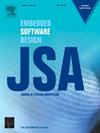近似加法器的新型混合概率-统计误差度量
IF 4.1
2区 计算机科学
Q1 COMPUTER SCIENCE, HARDWARE & ARCHITECTURE
引用次数: 0
摘要
近似计算(AxC)已经成为提高容错应用程序性能和能源效率的一种很有前途的方法。近似加法器设计以有限的精度损失为代价,提供不成比例的能量和性能增益。现有的错误度量对错误的产生和传播提供了有限的见解,并且与最终应用程序结果质量(QoR)的相关性很差。在本文中,我们提出了四个新的误差度量近似加法器,汇集了最好的统计和概率方法。这些度量基于概率加法器相关的错误生成向量(AGV)和输入相关的错误传播向量(IPV)。我们提出的度量从传播中解耦误差产生,并对加法器特性和(依赖于应用程序的)输入分布的影响进行建模。用28个近似加法器对三个真实世界的应用(高斯平滑、支持向量机和神经网络在MNIST、CIFAR-10和ImageNet等数据集上进行评估)进行了广泛的评估,结果表明,我们的指标与应用QoR的相关性比平均相对误差距离(MRED)、最坏情况误差(WCE)或错误率(ER)等传统指标更强。我们的指标还有助于确定适合不同应用的加法器设计。我们将开放我们的代码。本文章由计算机程序翻译,如有差异,请以英文原文为准。
Novel hybrid probabilistic–statistical error metrics for approximate adders
Approximate computing (AxC) has emerged as a promising approach for improving error-tolerant applications’ performance and energy efficiency. The approximate adder designs provide disproportionate energy and performance gains at the cost of a bounded loss in precision. The existing error metrics provide limited insights into error generation and propagation and correlate poorly with end-application quality-of-result (QoR). In this paper, we propose four novel error metrics for approximate adders that bring together the best of statistical and probabilistic approaches. These metrics are based on the probabilistic adder-dependent error-generation vector () and the input-dependent error-propagation vector (). Our proposed metrics decouple error generation from propagation and model the impact of both adder characteristics and (application-dependent) input distribution. Extensive evaluation with 28 approximate adders over three real-world applications (Gaussian Smoothing, Support Vector Machine, and Neural Network evaluated on datasets such as MNIST, CIFAR-10, and ImageNet) shows that our metrics are more strongly correlated with application QoR than conventional metrics such as mean relative error distance (MRED), worst-case error (WCE) or error-rate (ER). Our metrics also help identify suitable adder designs for different applications. We will open-source our code.
求助全文
通过发布文献求助,成功后即可免费获取论文全文。
去求助
来源期刊

Journal of Systems Architecture
工程技术-计算机:硬件
CiteScore
8.70
自引率
15.60%
发文量
226
审稿时长
46 days
期刊介绍:
The Journal of Systems Architecture: Embedded Software Design (JSA) is a journal covering all design and architectural aspects related to embedded systems and software. It ranges from the microarchitecture level via the system software level up to the application-specific architecture level. Aspects such as real-time systems, operating systems, FPGA programming, programming languages, communications (limited to analysis and the software stack), mobile systems, parallel and distributed architectures as well as additional subjects in the computer and system architecture area will fall within the scope of this journal. Technology will not be a main focus, but its use and relevance to particular designs will be. Case studies are welcome but must contribute more than just a design for a particular piece of software.
Design automation of such systems including methodologies, techniques and tools for their design as well as novel designs of software components fall within the scope of this journal. Novel applications that use embedded systems are also central in this journal. While hardware is not a part of this journal hardware/software co-design methods that consider interplay between software and hardware components with and emphasis on software are also relevant here.
 求助内容:
求助内容: 应助结果提醒方式:
应助结果提醒方式:


